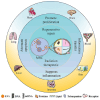Mesenchymal Stem Cell-Derived Extracellular Vesicles for Regenerative Applications and Radiotherapy
- PMID: 39780320
- PMCID: PMC11713979
- DOI: 10.1177/09636897241311019
Mesenchymal Stem Cell-Derived Extracellular Vesicles for Regenerative Applications and Radiotherapy
Abstract
Tissue repair is an extremely crucial part of clinical treatment. During the course of disease treatment, surgery, chemotherapy, and radiotherapy cause tissue damage. On the other hand, Normal tissue from accidental or therapeutic exposure to high-dose radiation can cause severe tissue damage. There is an urgent need for developing medical countermeasures against radiation injury for tissue repair. Tissue repair involves the regeneration, proliferation, differentiation, and migration of tissue cells; imbalance of local tissue homeostasis, progressive chronic inflammation; decreased cell activity and stem cell function; and wound healing. Although many clinical treatments are currently available for tissue repair, they are expensive. The long recovery time and some unavoidable complications such as cell damage and the inflammatory reaction caused by radiotherapy have led to unsatisfactory results. Extracellular vesicles (EVs) derived from mesenchymal stem cells (MSCs) have similar tissue repair functions as MSCs. In tissue damage, EVs can be used as an alternative to stem cell therapy, thereby avoiding related complications such as immunological rejection. EVs play a major role in regulating tissue damage, anti-inflammation, pro-proliferation, and immune response, thus providing a diversified and efficient solution for the repair of disease- and radiotherapy-induced tissue damage. This article reviews the research progress of mesenchymal stem cell-derived EVs in promoting the repair of tissue including heart, lung, liver, intestine, skin, blood system, central nervous system, and tissue damage caused by radiotherapy, thereby aiming to offer new directions and ideas for the radiotherapy and regenerative applications.
Keywords: extracellular vesicles; mesenchymal stem cells; radiation damage; regenerative repair.
Conflict of interest statement
Declaration of Conflicting InterestsThe author(s) declared no potential conflicts of interest with respect to the research, authorship, and/or publication of this article.
Figures


Similar articles
-
Mesenchymal Stem Cell Derived Extracellular Vesicles for Tissue Engineering and Regenerative Medicine Applications.Cells. 2020 Apr 16;9(4):991. doi: 10.3390/cells9040991. Cells. 2020. PMID: 32316248 Free PMC article. Review.
-
Roles of extracellular vesicles from mesenchymal stem cells in regeneration.Mol Cells. 2024 Dec;47(12):100151. doi: 10.1016/j.mocell.2024.100151. Epub 2024 Nov 13. Mol Cells. 2024. PMID: 39547584 Free PMC article. Review.
-
Recent advances in the use of extracellular vesicles from adipose-derived stem cells for regenerative medical therapeutics.J Nanobiotechnology. 2024 Jun 6;22(1):316. doi: 10.1186/s12951-024-02603-4. J Nanobiotechnology. 2024. PMID: 38844939 Free PMC article. Review.
-
Perspectives for Future Use of Extracellular Vesicles from Umbilical Cord- and Adipose Tissue-Derived Mesenchymal Stem/Stromal Cells in Regenerative Therapies-Synthetic Review.Int J Mol Sci. 2020 Jan 25;21(3):799. doi: 10.3390/ijms21030799. Int J Mol Sci. 2020. PMID: 31991836 Free PMC article. Review.
-
Mesenchymal Stem Cell-Derived Extracellular Vesicles in Tissue Regeneration.Cell Transplant. 2020 Jan-Dec;29:963689720908500. doi: 10.1177/0963689720908500. Cell Transplant. 2020. PMID: 32207341 Free PMC article. Review.
Cited by
-
Extracellular vesicles and miRNA-based therapies in triple-negative breast cancer: advances and clinical perspectives.Extracell Vesicles Circ Nucl Acids. 2025 Feb 14;6(1):54-71. doi: 10.20517/evcna.2024.85. eCollection 2025. Extracell Vesicles Circ Nucl Acids. 2025. PMID: 40206796 Free PMC article. Review.
-
Priming effect of photobiomodulation of mesenchymal stem cells on extracellular vesicles for regenerative medicine.Mol Biol Rep. 2025 Jul 12;52(1):707. doi: 10.1007/s11033-025-10791-x. Mol Biol Rep. 2025. PMID: 40650674 Review.
References
-
- Cabrera M, Ungermann C. Guiding endosomal maturation. Cell. 2010;141(3):404–406. - PubMed
Publication types
MeSH terms
LinkOut - more resources
Full Text Sources
Medical

